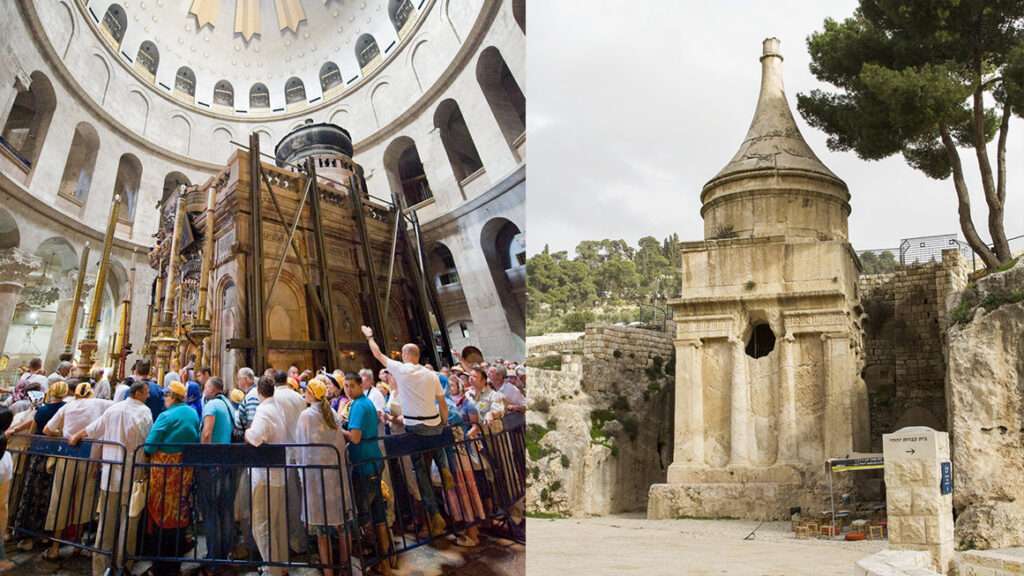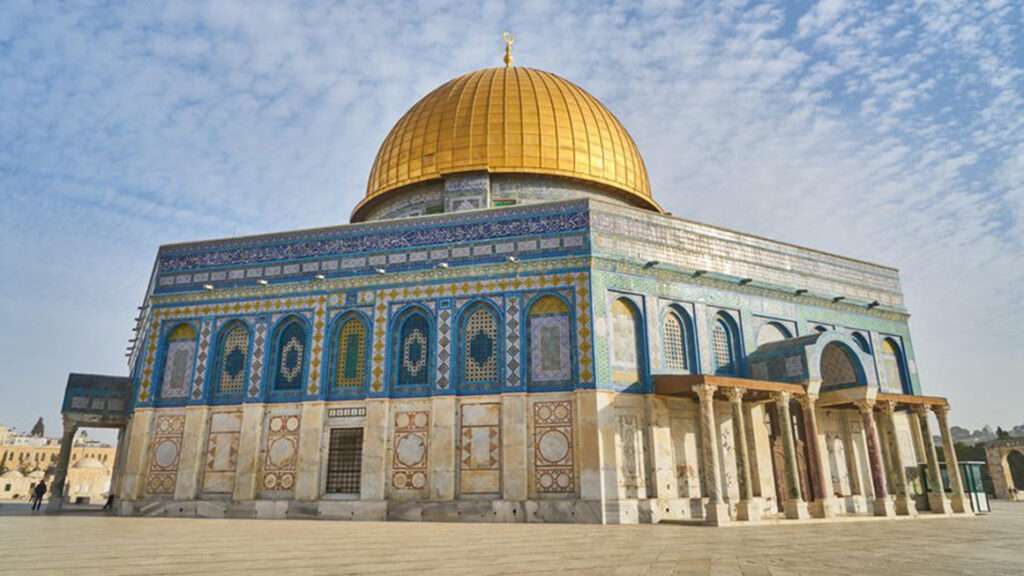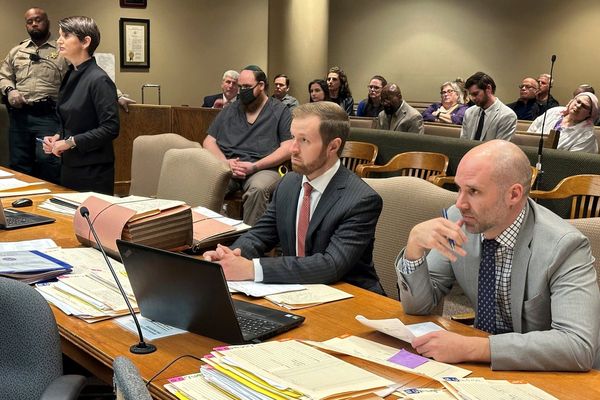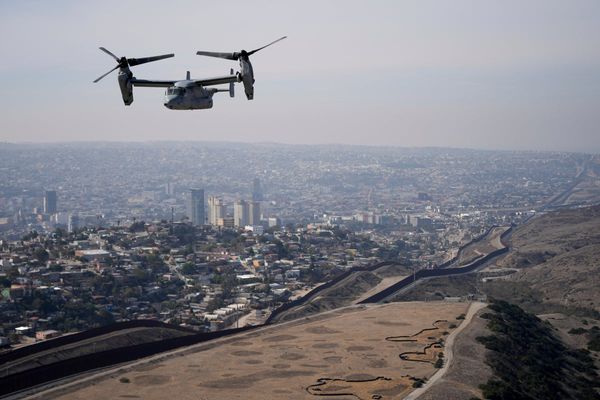This is part of Reason's 2025 summer travel issue. Click here to read the rest of the issue.
The Church of the Holy Sepulchre, traditionally identified as the site of Jesus Christ's crucifixion and resurrection, is shared by half a dozen denominations under a baroque "status quo" agreement signed in 1757. The agreement, which could be viewed as an attempt to reduce conflict by establishing something like property rights, aimed to prevent interdenominational violence, which nevertheless occasionally breaks out between clerics with contradictory views of the prerogatives assigned to each group.
Near the church's entrance is a conspicuous symbol of that uneasy arrangement: a three-century-old wooden ladder that connects a ledge to an upper-level window. Although that section of the building is assigned to the Armenian Apostolic Church, no one is allowed to mess with the "immovable ladder," lest all hell break loose.

Old as they are, the clashes that inspired the status quo pact are recent by local standards. The original church, completed in 335 C.E. under Constantine the Great, replaced a pagan temple that Hadrian had built over a Jewish burial ground. The church was destroyed in 1009 at the order of Fatimid ruler al-Hakim bi-Amr Allah and rebuilt by Byzantine emperors in the mid-11th century.
All of that amounts to a small but representative slice of Jerusalem's 5,000-year history, which features a long succession of powers contending for control of the same territory, including Canaanites, Egyptians, Israelites, Assyrians, Babylonians, Persians, Greeks, Romans, Byzantines, various Arab caliphates, Crusaders, Mamluks, Ottomans, and a fading British Empire. The City of Peace has been a locus of conflict for a very long time—a story that continues to this day.
The status of Jerusalem, which was divided between Israel and Jordan until the Six-Day War of 1967, has always been the trickiest issue for negotiators who imagine a two-state solution to the Israeli-Palestinian conflict. While both sides claim history is on their side, a longer view reveals a series of conquests and legal regimes that makes the question of just or rightful ownership difficult to resolve in any definitive way. For visitors to Jerusalem, the upside of that complicated history is that it left behind traces of all those civilizations, piled one atop another.
You can get a sense of that history at the Israel Museum (in West Jerusalem, near the Knesset) or the Rockefeller Archaeological Museum (in East Jerusalem, near Herod's Gate), both of which are well worth a visit. But there is no substitute for walking around the city, which is endlessly fascinating.
The first settlement in the area dates to 3000 BCE. It was located near the Gihon Spring in the Kidron Valley, which is connected to the Pool of Siloam in the City of David by a 1,750-foot tunnel. The Hebrew Bible describes the tunnel as the work of Hezekiah, the Judean king whose reign ended around 687 BCE. You can still walk or wade (depending on the weather) through that tunnel, although you may have to crouch a bit to avoid bumping your head.
Nomenclature in and around the Old City can be confusing. The Tomb of Absalom, for instance, has nothing to do with Absalom, and the Tower of David has nothing to do with King David, except that he reportedly was a musician and the site that bears his name is a memorable setting for outdoor concerts. The Jerusalem Light Festival, held in June each year, is another striking contrast of old and new, featuring illuminated displays and projections against ancient walls and buildings.

The Western Wall, the main Old City attraction for observant Jews, is a bit of a puzzle. Although it was the first section of the retaining wall around the Temple Mount that became accessible to Jewish worshippers after the 1967 war, it is not obviously holier than any of the subsequently exposed bits. To the left are tunnels along the retaining wall, where a guided tour sheds light on the question of how low-tech builders managed to cut, transport, and place massive blocks of Jerusalem stone weighing anywhere from two to 600 tons. To the right is the Ophel Archeological Park, where you can walk on a paved street from the Second Temple period and see the remnant of an overpass above the street, along with ritual baths from the same period and Byzantine homes with mosaic floors.
There is a lot more to see in the Old City, including the Arab Souk and the Temple Mount itself, which is now the site of the Dome of the Rock and Al-Aqsa Mosque, distinctive features of the Jerusalem skyline. You can get a pretty good overview by walking on the northern and southern ramparts of the Old City. The northern walk runs from the Jaffa Gate to the Lions' Gate, while the southern walk begins at the Tower of David and ends between the Zion Gate and the Dung Gate—the counterintuitive name for the entrance closest to the Western Wall.
When I lived in Jerusalem several years ago, I enjoyed the free walking tours that used to leave from City Hall on Saturdays, which frequently ventured beyond the usual points of interest. The subjects included leper asylums, Mamluk architecture, 19th century accommodations for Russian Orthodox pilgrims, and the Templer origins of the German Colony neighborhood. There is always more to learn about the city, often in places you thought were familiar.
Another relatively obscure attraction will be of special interest to libertarians. Although the Ministry of Finance's Tax Museum on Agripas Street tries to put a positive spin on the government's forcible extraction of revenue, the exhibits reflect centuries of resistance to such demands.
In addition to all the historical and religious sites, Jerusalem is a modern city of about 1 million people, more than twice the population of Tel Aviv–Yafo. There is no beach, but the weather is less humid and more pleasant than in cities along the Mediterranean, with cool breezes to relieve the summer heat. And while Tel Aviv fans may not be impressed by Jerusalem's nightlife, it has come a long way in the last few decades.
The Machane Yehuda market area, which features a plethora of shops selling everything from baked goods and fresh produce to luggage and hardware, used to shut down at night. But now it comes alive with music and crowds drawn by a range of bars and restaurants. Other lively spots include the Ben Yehuda pedestrian mall, the Mamilla mall (northwest of the Jaffa Gate, near the intersection of King David, King Solomon, and Agron streets), and Tachana Rishona, an outdoor mall on the site of an old train station at the end of Emek Refaim Street.
Like Jerusalem's nightlife, Israeli beer, wine, and liquor have undergone a renaissance. Budweiser-like lagers have been joined by a wide range of styles made by craft brewers across the country, vintners in several distinct regions produce highly rated wines, and microdistillers make better-than-passable gins and whiskies.
For whiskey in Jerusalem, my favorite spot is the cozy Glen Whisk(e)y Bar, which has an impressive selection. The owner of that place also operates the Rabbit Hole, a whimsically decorated gin bar on Yanai Street, and Biratenu, a beer bar on Hillel Street. The better cocktail bars include Zuta, tucked in the back of a restaurant on King David Street called 1868, and the Gatsby Cocktail Room, a speakeasy-style joint on Hillel Street. The latter is easy to miss if you don't know it's there—which is true of many things that are worth exploring in Jerusalem.
All of that sounds cool, you may be thinking, but is it worth the risk of dying in a terrorist attack? Like the danger of mass shootings in the United States, that risk has always been much lower than you might surmise from news reports, and that remained true even after Israel's latest war with Hamas began in October 2023.
The Israel Security Agency has reported four civilian deaths from terrorism in Jerusalem since then, all of which occurred during the same incident on November 30, 2023. Israeli defense systems have been remarkably effective at neutralizing rocket and missile attacks, with no deaths reported in Jerusalem. And overall, crime rates in Israel are much lower than crime rates in the United States. Jerusalem looks quite safe compared to Dallas, where I live, for example.
In fact, given the ongoing territorial disputes, life in Jerusalem is remarkably peaceful. For the most part, people of different faiths, cultures, and ethnic backgrounds manage to coexist, their tensions lubricated by commerce, the need to accomplish quotidian tasks, and a mutual interest in avoiding open conflict. That situation is far from ideal. But as the clerics at the Church of the Holy Sepulchre could tell you, it is preferable to the alternative.
The post Conflicts and Contrasts Make Jerusalem Endlessly Fascinating appeared first on Reason.com.







